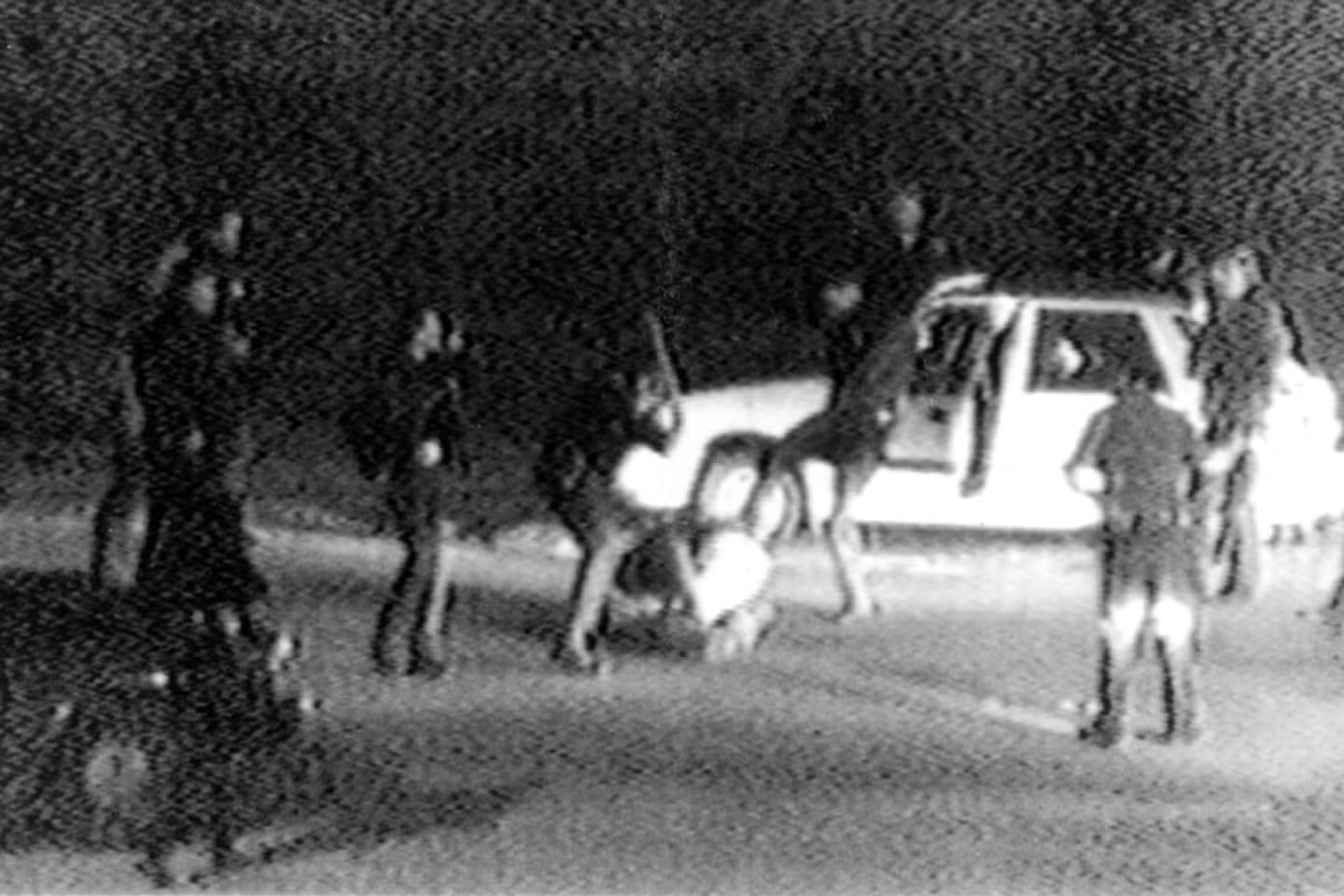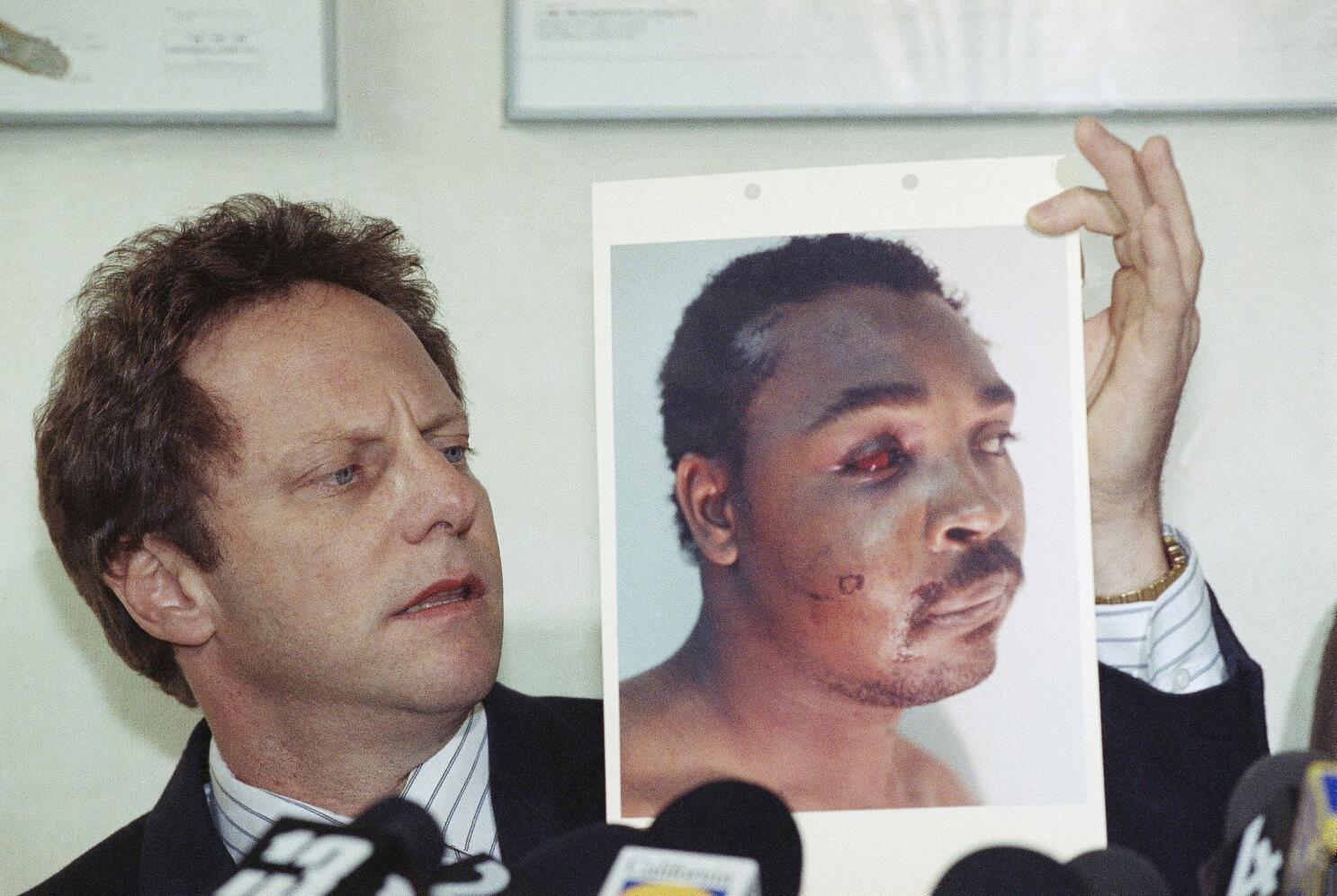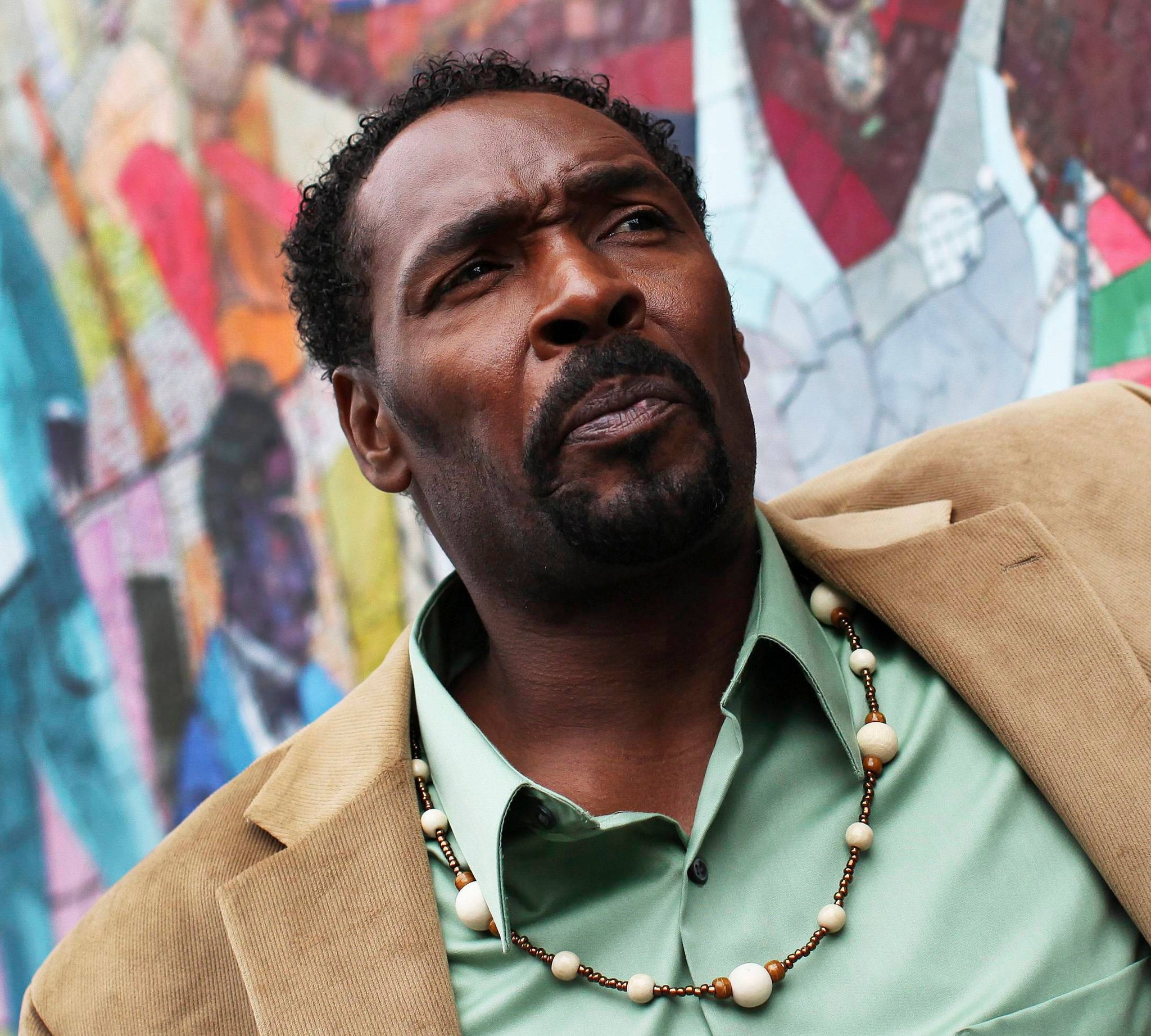One man, one banner, one amateur video: on March 3, 1991, Rodney King was brutally beaten by Los Angeles police officers. Filmed, the scene sent shockwaves around the world and sparked historic riots. For Rodney King, a symbol of police brutality, justice stumbled—but history awoke.
Rodney King confronts police violence

Rodney Glen King was born on April 2, 1965, in Sacramento, California. He was the son of Ronald and Odessa King, in an African American family marked by poverty and a father’s alcoholism. His father, a worker in the dairy industry, died at 42 from cirrhosis. The trauma left a lasting impact on Rodney, who would later struggle with addiction himself.
Raised in an unstable environment, King struggled in an educational system that had little to offer poor Black youth. He bounced between odd jobs—working as a laborer at Dodger Stadium, among others—and had frequent run-ins with the law: petty theft, assault, drunk driving… In 1989, he was sentenced to two years in prison for armed robbery at a convenience store. Paroled in late 1990, he tried to rebuild his life.
But on March 3, 1991, in Los Angeles, a simple speeding violation would catapult him—despite himself—into the center of the contemporary struggle against racist violence in the United States.
That night, Rodney King was driving on the I‑210 freeway in Los Angeles when a police radar caught him speeding. Recently paroled, he feared returning to prison and decided to flee. The chase lasted several miles and involved multiple police vehicles. Authorities also claimed he was suspected of carjacking—an accusation never proven.
Eventually, King pulled over near Lake View Terrace. Apparently intoxicated, he got out of the car, confused. At that moment, the police officers, armed with batons, surrounded him. They beat him violently for several minutes, even while he lay on the ground, defenseless.
But someone was watching from a nearby balcony: George Holliday, a neighborhood resident. He grabbed his camcorder and recorded what would become one of the most damning documents of modern history: 1 minute and 43 seconds showing 33 baton strikes and 7 kicks to an unarmed, helpless man.
The video, passed to local station KTLA, quickly spread worldwide. It revealed more than a case of police misconduct: it exposed a long-denied truth—racialized, institutional, and systemic violence in the United States.
On April 15, 1992, the trial of the four police officers involved in Rodney King’s beating began. The location—Simi Valley, a conservative suburb of Los Angeles with a predominantly white population—was telling. The jury included ten white members, one Latino, and one Asian American. There were no African Americans.

Despite the damning video, the defense attorneys managed to reframe the footage, breaking it down frame by frame to minimize its brutality. On April 29, 1992, the verdict came: three officers were acquitted. The fourth, Laurence Powell, was not found guilty either—resulting in a mistrial. None of the officers were convicted.
The reaction was swift and explosive. Within hours, Los Angeles descended into chaos. The rage that had simmered for decades erupted. It was no longer just about Rodney King—it was about years of police violence, discrimination, and judicial indifference.

This archive photo from April 29, 1992, shows buildings engulfed in flames before firefighters arrived, as riots broke out in South Central Los Angeles following the acquittal of the four officers. (AP Photo/Reed Saxon)
Between April 29 and May 4, 1992, the L.A. riots left:
- 63 dead
- Over 2,300 injured
- Over 12,000 arrested
- Nearly $1 billion in property damage
South Central burned, and communities of color united in a collective cry: Justice. Now.
George Holliday’s footage became one of the first viral videos of the pre-Internet era. Broadcast repeatedly on American and global networks, the grainy VHS sequence awakened collective awareness: what African Americans endured was brutal reality, long denied by institutions.
In response to global outrage and the trauma of the riots, federal authorities reopened the case.
In 1993, a federal trial was held for the violation of Rodney King’s civil rights. Two of the four officers—Stacey Koon and Laurence Powell—were found guilty and sentenced to 30 months in prison. It was a late, partial verdict, but a symbolic legal victory nonetheless.
In 1994, King filed a civil suit against the City of Los Angeles. This time, the outcome was unequivocal: the city was ordered to pay him $3.8 million in damages, plus $1.7 million in legal fees. A gesture of compensation that, for many, could never erase the original wound—public humiliation and judicial scorn.

Rodney King was born on April 2, 1965, in California. He was married to Crystal Lynnette Waters and Dennetta Lyles. He died on June 17, 2012, in California.
On May 1, 1992, the third day of the riots, Rodney King spoke in front of the cameras. His face bore the marks of his ordeal, his voice trembled—but he remained firm. He did not call for hate. He did not demand revenge. He spoke a simple, historic phrase:
“Can we all get along?”
This humble, rhetoric-free question became a universal plea—for peace, decency, and brotherhood. Amid fire and blood, Rodney King, victim of blatant injustice, became a messenger of reconciliation. He chose dignity over humiliation, peace over rage.
His message echoed far beyond Los Angeles. It became part of the collective memory of antiracist struggles. Nearly 30 years later, during protests for George Floyd, Breonna Taylor, or Tyre Nichols, this phrase returned like a painful refrain—a moral compass, the cry of a man who still believed in humanity., malgré tout, croyait encore en l’humanité.

Rodney King was not an activist. But with that one phrase, he became one of the most powerful modern symbols of African American nonviolence.
Despite financial compensation and belated recognition, post-1992 life was a long downward spiral for King. Haunted by trauma, he relapsed into alcohol and drugs, entering rehab multiple times without escaping his demons.
He was also involved in several domestic violence cases and faced arrests for drunk driving, parole violations, and drug possession. The man who became a symbol of fractured America found himself trapped in his own myth, unable to escape the shadow of the event that made him famous.
On June 17, 2012, at dawn, his fiancée found him lifeless at the bottom of their swimming pool in Rialto, near Los Angeles. He was 47. The autopsy revealed cocaine, alcohol, PCP, and marijuana in his system. His weakened heart likely gave out after a fall into the water.
Tragic irony: he died on June 17—a symbolic date for the African American struggle; exactly 41 years after Nixon’s arrest during the “war on drugs,” and 19 years to the day after his partial legal victory. Rodney King—the man filmed on his knees on the asphalt—died drowning in oblivion, without ever finding the peace he had longed for.
Rodney King wasn’t an activist, yet he became one of the earliest modern icons of resistance to police violence. Unintentionally, he opened a new era—one where abuse was no longer invisible, where cameras held power, and where witnesses became agents of justice. In this sense, he was a pioneer of copwatch, long before social media or smartphones.
His story awakened consciences, inspired generations of activists, journalists, grieving families, and young people fighting for civil rights. Every viral video of police abuse—from Trayvon Martin to George Floyd, from Tamir Rice to Tyre Nichols—carries, implicitly, the imprint of Rodney King on the ground, beaten, filmed.
Even today, the question he asked in 1992 remains unanswered:
- The weight of judicial impunity
- The power of visual evidence
- The persistence of racial divides
- The need for systemic reform, truth, and reconciliation
Rodney King didn’t just mark an era. He helped create a visual language of resistance, a grammar of peaceful struggle, and a duty of remembrance. His wavering but dignified figure remains etched in American history as a mirror held up to democracy—one where truth must be seen to be believed, and justice must be fought for.
Sources
– Washington Post, “Who was Rodney King? His 1991 beating by L.A. police roiled America.”, January 27, 2023
– AP News, “Today in History: April 29, Los Angeles riots after Rodney King verdict”
– Encyclopedia Britannica, “Rodney King and the L.A. Riots”
– Biography.com, “Rodney King Biography”
– Wikipedia (EN), “Rodney King”
– LATimes Archives, “Rodney King: the man, the myth, the media”
– USC Today, “Rodney King and the politics of forgiveness”
– George Holliday Archives, interview about the March 3, 1991 footage
– SCPR Project, “The Aftermath of Rodney King’s Beating”
– Yale Journal of Law & the Humanities, “Police Brutality and the Rodney King Case”
– Testimonies collected, 2012–2022, Los Angeles & California
– L.A. Police Violence Observatory, Special Report, 2020
Compiled, written, and contextualized by SK (Nofi)
Contents
- Rodney King Confronts Police Violence
- Sources
